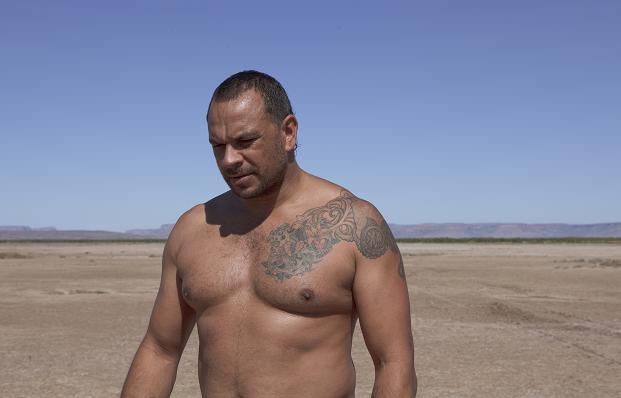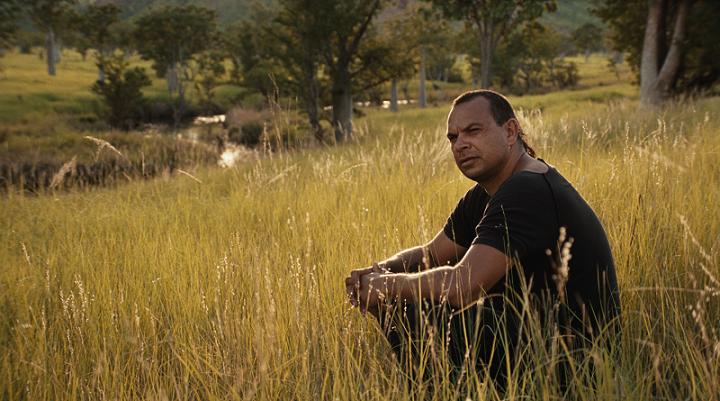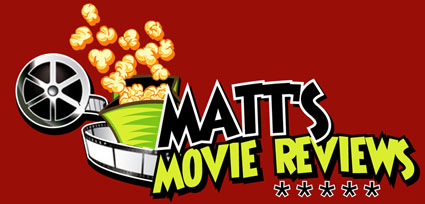Ask the average Australian cinema goer about Aussie film, and a less than flattering response might greet you.
The Australian Film Industry has garnered a reputation for producing material that is often bleak, morally over powering, and prime for art house cinemas, exactly what the average punter doesn’t want to see.
Films which focus on the bleak state of indigenous affairs are especially hard to sell, yet that is starting to change. Stone Bros. had people laughing at its self depreciating humour; Bran Nue Dae was a toe tapping triumph at the box office; and Samson and Delilah won almost every award imaginable, including the Camera d’Or award at the Cannes Film Festival.
Now comes Mad Bastards, a unique and moving film that wowed audiences at the Sundance and Adelaide film festivals.
The film stars newcomer Dean Daley-Hughes as TJ, a “mad bastard” who sets off on a journey across the country to visit his estranged son Bullet (Lucas Yeeda). While doing so he evokes the wrath of Bullet’s grandfather and local police officer Texas (Greg Tait).
“I really wanted to make this movie where people would say 'Who are these guys? What’s this music? Why haven’t I seen this country before?’” said writer/director Brendan Fletcher. “It was exciting for me to make something that was really fresh and really strong, but with people, music, and images you have never seen before.”
What exactly is a “mad bastard”, you ask? According to co-producer Stephen Pigram, “it’s generally used up that way as an endearing turn, for someone has a bit of ‘get up and go’”.
It’s a term which Fletcher fell head over gum boots for. “I love the boldness of the title. I love the fact that you don’t really know what the film is about from the title, that it’s a doorway that could lead anywhere. The film kind of announced itself through the title and said “Here I am”, and it’s a very masculine title which is appropriate for the film.”
The origins of Mad Bastards goes back almost 12 years, when a collaboration between Fletcher and acclaimed indigenous music duo Stephen and Alan Pigram, otherwise known as the Pigram Brothers, created both a lifelong friendship and the grounding for their first feature film.
“Brendan originally made some video clips for us back in Broome,” said Stephen Pigram. “Then we went on to make documentaries and a short film in 2000 called Kulli Foot, which won a little reward.”
“That was the spark,” continued Alan Pigram. “Making the short film and that sort of infrastructure of making a family in the Kimberley, inspired by the music and stuff. We just thought why not make a bigger one?”
For Brendan, it was an opportunity to leap from the world of music videos and documentary filmmaking and into feature films.
“I always had it in my mind that I would like to make a dramatic movie, but I decided I didn’t want to hurry it and not make a film just for the sake of making a movie. I wanted to make until I had something to say and something to make,” said Brendan. “I suppose because I worked with the Pigram Brothers up in the Kimberley making videos and documentaries, it was kind of around that period of the late ‘90s that I thought, ‘Hang on...there could be a movie here’. So that was the moment when it crystallised, but that was in early 2000, and then it was a long development period”
 |
“This is a story about a man who wants to change his life around and turn a new leaf in his life. This is gonna inspire other people." - Dean Daley-Jones |
The origins of Mad Bastards goes back almost 12 years, when a collaboration between Fletcher and acclaimed indigenous music duo Stephen and Alan Pigram, otherwise known as the Pigram Brothers, created both a lifelong friendship and the grounding for their first feature film.
“Brendan originally made some video clips for us back in Broome,” said Stephen Pigram. “Then we went on to make documentaries and a short film in 2000 called Kulli Foot, which won a little reward.”
“That was the spark,” continued Alan Pigram. “Making the short film and that sort of infrastructure of making a family in the Kimberley, inspired by the music and stuff. We just thought why not make a bigger one?”
For Brendan, it was an opportunity to leap from the world of music videos and documentary filmmaking and into feature films.
“I always had it in my mind that I would like to make a dramatic movie, but I decided I didn’t want to hurry it and not make a film just for the sake of making a movie. I wanted to make until I had something to say and something to make,” said Brendan. “I suppose because I worked with the Pigram Brothers up in the Kimberley making videos and documentaries, it was kind of around that period of the late ‘90s that I thought, ‘Hang on...there could be a movie here’. So that was the moment when it crystallised, but that was in early 2000, and then it was a long development period”
During that period, casting the right people to play these “mad bastards” became a vital and extensive search.
“We didn’t want to bring in actors who would act like these characters,” said Brendan. “So we sort of did it inside out and looked inside the community, and got these guys in front of the camera and develop them as actors.”
As a result, an organic filmmaking process began to emerge, with the actors feeding their own experiences into the screenplay, creating a work that is immensely personal and authentic.
“Yeah, definitely. We had our first round of proper script development back in 2003, and before that with our first bunch of money we started shooting without a script behind it, because if it didn’t work with non-actors then I wasn’t even going to start the writing process, because I really wanted to create something original in the Kimberly” revealed Brendan.
Key inspiration was found in Dean Daley-Jones, whose struggle to put behind his own alcohol fuelled, violent past, inspired Fletcher to re-write key aspects of the film.
“I had this very clear vision of the film that it was a Kimberley movie, and that it would be filmed and set in the Kimberley, and when I met Dean I thought, “God. This guy is great! But he’s not from the Kimberley,’” said Brendan. “Originally I wrote him in as this blow in who comes from out of town and gets into some trouble, and I sort of coaxed him in front of the camera, and he got more confident and we got more confident. When I got to the edit suite and saw all of this footage my eyes went from the other people and to Dean all of the time, so I started to think ‘Hang on. I think this guy has got something.’”
For Daley-Jones, playing the lead in a feature film was a dream come true, especially when his initial interest in Mad Bastards was as the film’s grip.
“I was in Broome working for a shed building company. Originally I came to Mad Bastards as a grip, because I had numerous years of experience working in different departments in the film industry,” said Daley-Jones. “I was introduced to Brendan and it turns out he had known some people I worked with in Sydney, and so he hired me as the grip in Mad Bastards.”
“A week later he calls me up and says, ‘I would like to talk to you about the film a little more.’ So we got together, and he asked if he could know a little more about myself...I think he heard through the grapevine that I had a bit of a colourful past, so he wanted to hear some stories about that. Then he asked me to do a screen test, and here I am. (laughs)”
That “colourful past” which Daley-Jones referred to helped shape the character of TJ, and became a cathartic experience for the burgeoning indigenous actor.
“Well the film is not about me, but there is a lot that I have experienced in my own life that fed into what the character of TJ was going through. The challenges and the demons, stuff like that,” confessed Daley-Jones.
 |
“I really wanted to make this movie where people would say 'Who are these guys? What’s this music? Why haven’t I seen this country before?’”- writer/director Brendan Fletcher |
“But if I were still like that, I don’t think I could have delivered that performance. I am more at peace at myself and with the world, even when I met Brendan. I am still on my journey and will be for the rest of my life, but I’m not that crazy mad bastard any more. I’m now a good mad bastard!”
Key to the film’s success was the environment which the film was set and filmed in. The Kimberley is a unique region located in the far north of Western Australia. While many have laid claim to have filmed there (Baz Luhrman shot his Australia in the outskirts of the region), Fletcher and the Pigram Brothers were adamant that Mad Bastards be shot in the heart of the Kimberley.
“There are lots of larger than life characters up in the Kimberley”, said Stephen Pigram. “It’s one of the last places in Australia that is sort of really remote, rugged and beautiful at the same time.”
However, filming in the Kimberley proved to be a problematic experience for Fletcher and his crew, with the logistics of making a movie in the middle of nowhere often daunting.
“Sometimes I was thinking ‘Why did we make it so hard for us to organise?’” confessed Fletcher. “How do you feed people? At times we were just in the middle of nowhere, and if you’re not a big production you can’t afford catering or a Port-a-Loo so people can go to the toilet.”
“Sometimes the nearest town was 1200 kilometres away. I couldn’t see the rushes until much afterwards and I suppose from a technical point of view I didn’t mind that, because I made short films with the Pigram Brothers and we followed a similar process, so it was ok to not see the material straight away. But it was the logistics that was the difficult thing.”
In the end, the difficulty of shooting in the Kimberley with a small budget was a rewarding experience.
“I really wanted to film something people have never seen before,” said Fletcher. “It was one thing to shoot a documentary up there, but making a movie? A whole different story. But it’s worth it. I mean, look where we are. We were at Sundance, so I’m very happy that we did it, but it was very hard.”
Another hurdle is the fact that Australian audiences are rejecting local cinema, especially those that deal with confronting cinematic themes as seen in Mad Bastards.
“Well there is no point in making a movie no one is going to see!” said Fletcher. “I didn’t want to make a film that was too bleak, and it’s not because of what the audience thinks. I wanted to make a film about a place and takes us to that place.”
“There are so many Kimberly men who have turned themselves around. Greg Tait is a classic example, and Dean is a classic example of that. Greg has an incredible story. He was a bonafide mad bastard. He was locked up before he was 12 years old, and he was the last bloke on record to break out of Broome prison. He almost lost everything, all of his kids, his wife left him, gave up the grog when he was 21 or 22 years old, joined the army, became a police man, and now he’s in a film!”
It all comes down to the main theme in Mad Bastards: the exploration and attainment of manhood. Responsible, upright, and filled with moral strength.
“Exactly! That was my main purpose for being involved,” said Daley-Jones. “This is a story about a man who wants to change his life around, turn a new leaf in his life, and you get a feeling he is doing that in the end. This is gonna inspire other people. Not just aboriginal men in the community, but people around the world, which is happening. Ever since it came out, it’s been a universal story.”
Also universal is the power of music, and in the collaboration of the Pigram Brothers and acclaimed singer/songwriter Alex Lloyd, a unique, soulful, and infectious soundtrack was created.
“Brendan always had the soundtrack in his head, and the music always developed along with the script,” said Stephen Pigram. “As producers initially it was about working with Brendan, but it was also a great way to provide music, and what a better art form than a feature film?”
For Alex, joining Fletcher and the Pigram Brothers in this artistic journey was a no-brainer.
“Brendan asked me to come out around 4 or 5 years ago, that he was making a film and would I like to collaborate with the Pigram Brothers”, said Lloyd. “I said yes straight away, because the idea of experiencing the Kimberly was enticing enough, let alone being a part of his first feature.”
Where the soundtrack for Mad Bastards differed from over movies was Fletcher’s idea of featuring these compositions from and centre, with the Pigrams and Lloyd on screen performing their songs alongside cast and the breathtaking Kimberly landscape.
“I always wanted to do that. I never wanted the music to be a soundtrack, like the radio in the background or in the next room”, said Fletcher. “To me it was about mixing unique music into a unique movie, from a unique part of the world, and the music has such a strong element that I didn’t want to let it be relegated to the background, so I just put the Pigram Brothers playing the songs into the scene.”
With its blend of drama, location, and music, Mad Bastards has made waves not only in Australia, but also overseas with a stint at the Sundance Film Festival, bringing home the reality that this universal story has indeed found an international audience.
“Sundance was just unreal!” enthused Daley-Jones. “It was the first time I had ever been overseas, first time I’ve ever seen snow...the whole 12 days I was there, waking up and looking outside my windows and wondering ‘What the fuck?’ at these big icicles hanging over the window and snow everywhere...it felt like I was in a Bing Crosby movie. (laughs) It was just beautiful.”
“What was great for us was we didn’t know how it was going to play at Sundance”, said Fletcher. “We hadn’t really shown it to anyone. Would they understand the language? Would it be too aboriginal? Would they get the story?"
" The great thing was that afterwards we had people from the screenings coming up to us from all over the world. Americans, Europeans, guys from Hawaii...everywhere, and they were all saying ‘I’ve been through that’, or ‘I know someone just like that’, or ‘My next door neighbour is like that all the time’. It was a fairly universal story. It might be set in a very unique part of the world, but it was about a story of a family reconnecting and trying to live their lives together. The great thing about it was that it resonated across the board. Not just with the aboriginal audience, or an Australian audience.”
|
